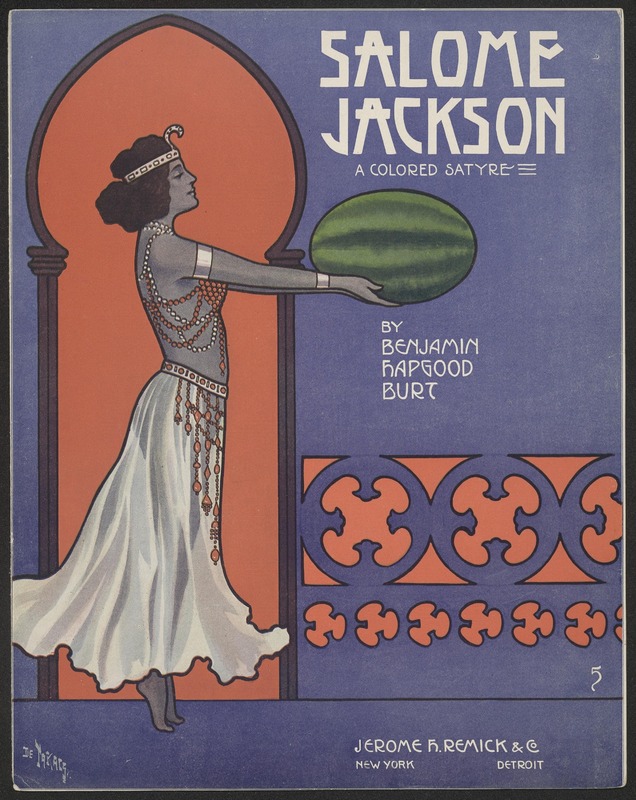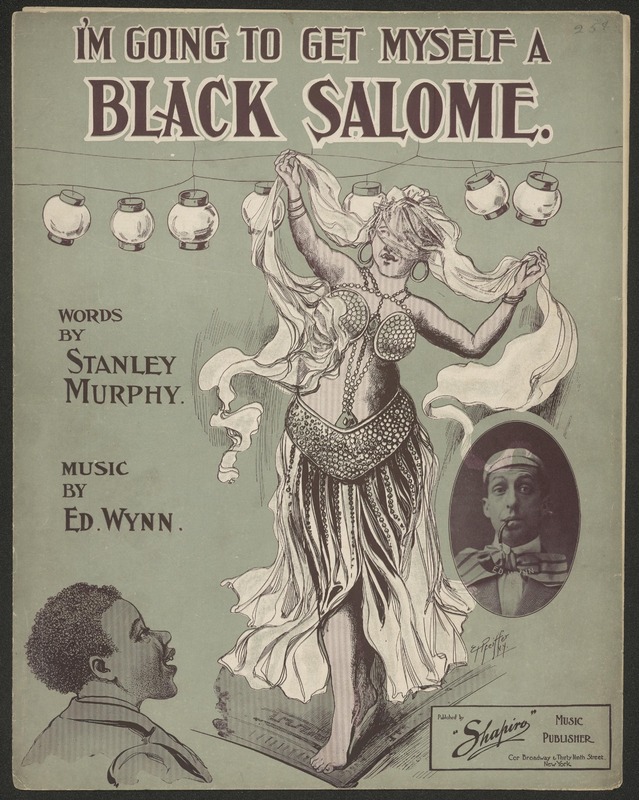Layered Racism
Salome Jackson: A Colored Satyre
Salome Jackson: A Colored Satyre was published in the U.S. in 1908. Right off the bat, the cover provides a glimpse into the unique style of the song and lyrics. A Black woman, barely covered in strings of beads and a sheer skirt, has her hands outstretched, holding a watermelon against the backdrop of more familiar, stereotypical Middle-Eastern architecture. The watermelon is a blatant reference to the popular racist stereotypes held against Black people. At the same time, there is an interesting overlap between anti-Black racism and Middle Eastern stereotypes.
This is further observed in the lyrics. The song follows a female dancer named Lucy, who is described as “very fat and black. To see her from the back, you’d swear it was a hack.” This simple description demonstrates how Black people are portrayed in popular media, drawing clear associations to ugliness and dehumanization. The racism continues, describing Lucy as looking more like three or four Salomes instead of one, and utilizing several anti-Black slurs to describe the Black men watching her. The men are described as yelling and shouting, crowding around Lucy when she brings out a watermelon and dances around it. These lyrics characterize the predominantly Black male audience as animal-like, rowdy, unintelligent, and mannerless.
The author also writes: “[they] haven’t got a chance in a barefoot dance, Miss Jackson, with you.” By describing the dance as a “barefoot” dance, the author could simply be including a fact about the dance style. However, the author could also potentially be implying a lack of civilization both in regards to the Middle East, where the dance stems from, or Black Americans, specifically Lucy. This song also begs the question: why choose the Salome dance? Is it used as a mockery of the Middle East, or inspired by American minstrel shows? Or was it simply a trend during the time period which was easy to capitalize on?
Overall, the lyrics offer a demeaning portrayal of Black people in America while incorporating Middle Eastern stereotypes.
I'm Going to Get Myself a Black Salome
I’m going to get myself a Black Salome, published in 1908, is another interesting case of an overlapping of races. These themes are most prominently demonstrated through the song lyrics. To start, the lyrics describe a Black American man saying, “Ev’ry month I’ve got to buy my babe a dress,/ Then the landlord hands me out a dispossess.” This statement could be interpreted as an allusion to the economic struggle of living in America as a Black individual. However, the lyrics then say, “I’m going to get myself a Black “Salomee”/ A Hootchie Kootchie dancer from Dahomey/ All that she’ll wear is a yard of lace.” These lyrics potentially imply that the Middle East is poorer and cheaper. At the same time, they also illustrate the sexualization of Middle Eastern women. This is further supported when the song writes: “And then she can wiggle out of paying rent.” Once again, this contributes to the theme of women only being powerful when it comes to their sexuality, and this power is described in a more negative light as deceitful and manipulative. Overall, this song is a reminder that Black Americans, who were heavily oppressed, can also participate in the production of Middle Eastern racism as well.

